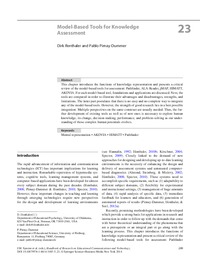Model-Based Tools for Knowledge AssessmentDirk Ifenthaler, Pablo Pirnay-Dummer
Zu finden in: Handbook of Research on Educational Communications and Technology (Seite 289 bis 301), 2014
|
 |
 Diese Seite wurde seit 6 Jahren inhaltlich nicht mehr aktualisiert.
Unter Umständen ist sie nicht mehr aktuell.
Diese Seite wurde seit 6 Jahren inhaltlich nicht mehr aktualisiert.
Unter Umständen ist sie nicht mehr aktuell.
 Zusammenfassungen
Zusammenfassungen
 This chapter introduces the functions of knowledge representation and presents a critical review of the model-based tools for assessment: Pathfinder, ALA-Reader, jMAP, HIMATT, AKOVIA. For each model-based tool, foundations and applications are discussed. Next, the tools are compared in order to illustrate their advantages and disadvantages, strengths, and limitations. The latter part postulates that there is no easy and no complete way to integrate any of the model-based tools. However, the strength of good research lies in a best possible integration: Multiple perspectives on the same construct are usually needed. Thus, the further development of existing tools as well as of new ones is necessary to explore human knowledge, its change, decision-making, performance, and problem-solving as our understanding of those complex human potentials evolves.
This chapter introduces the functions of knowledge representation and presents a critical review of the model-based tools for assessment: Pathfinder, ALA-Reader, jMAP, HIMATT, AKOVIA. For each model-based tool, foundations and applications are discussed. Next, the tools are compared in order to illustrate their advantages and disadvantages, strengths, and limitations. The latter part postulates that there is no easy and no complete way to integrate any of the model-based tools. However, the strength of good research lies in a best possible integration: Multiple perspectives on the same construct are usually needed. Thus, the further development of existing tools as well as of new ones is necessary to explore human knowledge, its change, decision-making, performance, and problem-solving as our understanding of those complex human potentials evolves. Dieses Kapitel erwähnt ...
Dieses Kapitel erwähnt ...
 Zitationsgraph (Beta-Test mit vis.js)
Zitationsgraph (Beta-Test mit vis.js)
 1 Erwähnungen
1 Erwähnungen 
- Second Handbook of Information Technology in Primary and Secondary Education (Joke Voogt, Gerald Knezek, Rhonda Christensen, Kwok-Wing Lai) (2018)


- 41. Making Use of Data for Assessments: Harnessing Analytics and Data Science (Dirk Ifenthaler, Samuel Greiff, David Gibson)


- 41. Making Use of Data for Assessments: Harnessing Analytics and Data Science (Dirk Ifenthaler, Samuel Greiff, David Gibson)
 Anderswo finden
Anderswo finden
 Volltext dieses Dokuments
Volltext dieses Dokuments
 |  Model-Based Tools for Knowledge Assessment: Artikel als Volltext bei Springerlink ( Model-Based Tools for Knowledge Assessment: Artikel als Volltext bei Springerlink ( : :  , 375 kByte; , 375 kByte;  : :  2020-11-28) 2020-11-28) |
 Anderswo suchen
Anderswo suchen 
 Beat und dieses Kapitel
Beat und dieses Kapitel
Beat hat Dieses Kapitel während seiner Zeit am Institut für Medien und Schule (IMS) ins Biblionetz aufgenommen. Beat besitzt kein physisches, aber ein digitales Exemplar. Eine digitale Version ist auf dem Internet verfügbar (s.o.). Aufgrund der wenigen Einträge im Biblionetz scheint er es nicht wirklich gelesen zu haben. Es gibt bisher auch nur wenige Objekte im Biblionetz, die dieses Werk zitieren.











 Biblionetz-History
Biblionetz-History